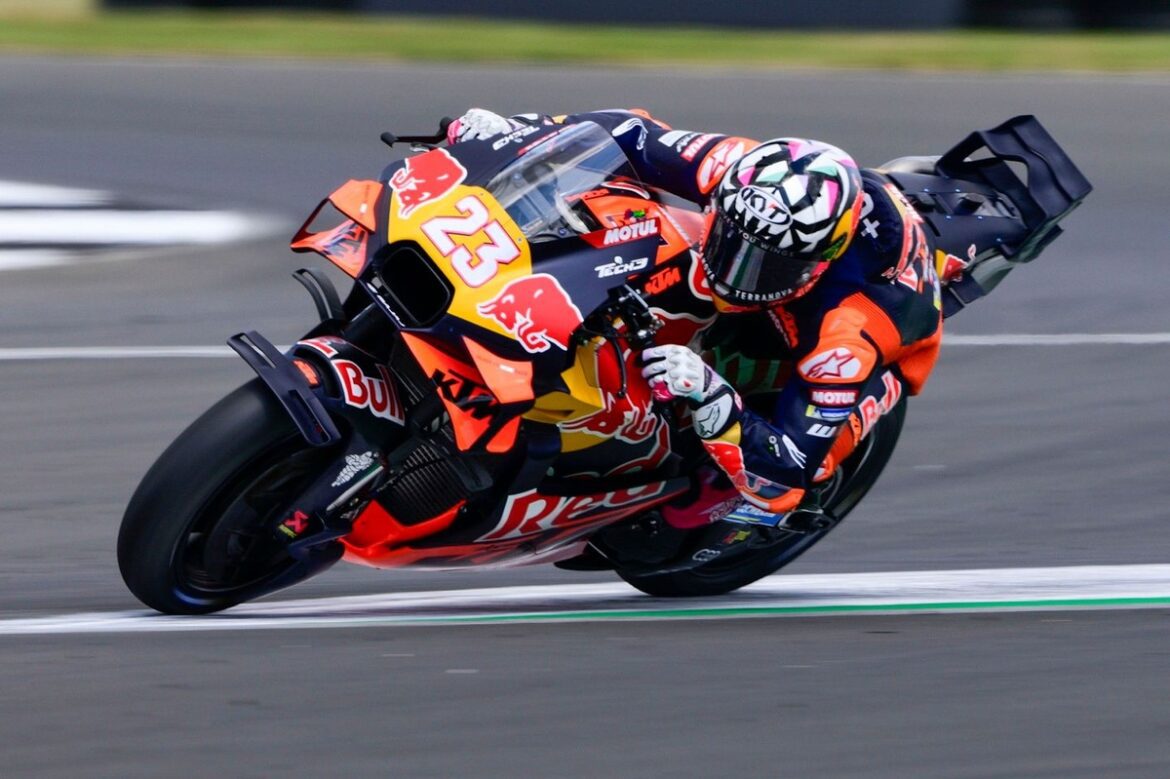Enea Bastianini’s Challenging Day at the British GP: A Deep Dive into MotoGP Struggles
In the realm of MotoGP, there are days that test the resilience and skill of even the most seasoned riders. One such occasion occurred at the British Grand Prix, where Enea Bastianini, riding for the KTM Tech3 team, faced a race that he has since described as the “worst” of his career. The conditions at Silverstone were anything but favorable, characterized by unpredictable gusts of wind that added an extra layer of difficulty to an already challenging race.
The Race Setup and Initial Challenges
Bastianini’s day began with a less-than-ideal start position, as he was placed 17th on the grid. These pre-race hurdles foreshadowed the difficulties he would encounter during the event. As the race progressed, Bastianini found himself unable to gain any traction, ultimately finishing in 17th place—a position he openly admitted was deeply unsatisfactory.
Reflecting on his experience, he revealed, “It has been a very complicated day for me,” expressing frustration over his inability to push the bike to its limits. The challenges he faced were not merely physical but also psychological, as the immense pressure to perform weighed heavily on him. The Italian rider did not shy away from expressing his disappointment, stating that the race was perhaps the lowest point of his career thus far.
Technical Difficulties and Performance Issues
Bastianini’s struggles extended beyond just personal performance; technical issues played a significant role in hindering his race. He mentioned experiencing problems with the front ride height device, which remained activated throughout the first lap. This malfunction further complicated his ability to navigate the track effectively. He lamented, “The bike doesn’t turn, and the electronics don’t work. This is the problem.”
Such technical difficulties can make or break a rider’s performance, especially in a competitive environment like MotoGP. The combination of a malfunctioning bike and challenging race conditions made it nearly impossible for Bastianini to find his rhythm. He expressed a sense of urgency for KTM to reassess his situation, implying that without significant improvements, his future in the sport could be jeopardized.
Comparisons with Fellow Riders
Bastianini was not alone in his misfortunes that day. His teammate, Brad Binder, who competes for the Red Bull KTM Factory Racing team, also had a dismal outing at Silverstone. Starting from 19th place, Binder managed to finish just ahead of Bastianini in 14th, but he too described the race as “horrendous.”
Binder articulated the struggles he faced with clarity, stating that he experienced excessive shaking on the straights and lacked confidence while cornering. He noted, “I have so much shaking down the straights and from corner to corner that I kept rolling the gas in the straights, which is never a good thing.” This lack of stability impeded his ability to maximize speed and cornering capabilities, essential elements for success in motorcycle racing.
The Psychological Toll of Performance Pressure
The mental aspect of racing cannot be overstated. Both Bastianini and Binder’s experiences underline the psychological challenges that come with competing at such a high level. Bastianini’s candid admission that he considered returning to the pits during the race reflects the mental strain he was under. “At the end, I closed the race for everybody, for me and for the team. But to be honest, I’m not happy for [anything],” he shared.
This lack of satisfaction can lead to a downward spiral in confidence, making it even more difficult to perform in subsequent races. Binder echoed similar sentiments, recognizing the need to regain his confidence. He remarked, “I need to find some confidence again, and I’m sure we’ll figure it out.”
Looking Forward: The Path to Recovery
As both riders navigate their current challenges, the focus will inevitably shift to how they can improve in future races. For Bastianini, the call for KTM to take action regarding his performance is crucial. He openly stated, “KTM needs to do something for me for my future, because like this, it’s impossible to continue, no?” This plea highlights the importance of team support and the need for continuous development of the bike to match the rider’s capabilities.
Binder, on the other hand, is also aware that finding solutions is critical for his career trajectory. The ability to adapt to changing conditions and overcome technical setbacks will be essential for both riders as they move forward in the season. The mental reset and the technical adjustments they make in the coming weeks could determine not just their performances but also their standings in the championship.
The Bigger Picture: Team Dynamics and Future Implications
The struggles faced by Bastianini and Binder are indicative of broader challenges within the KTM team. As they work to enhance their bikes and refine their techniques, the dynamics of teamwork and collaboration will be crucial. Communication between riders, engineers, and support staff can pave the way for innovative solutions to the issues they face.
Moreover, the MotoGP season is long, and a single race does not define a rider’s career. Both riders have shown exceptional talent in the past, and their ability to bounce back from adversity will be tested. The lessons learned from the British GP can serve as a foundation for growth.
Conclusion
In the world of MotoGP, each race presents a unique set of challenges that can impact the trajectory of a rider’s career. Enea Bastianini’s experience at the British GP serves as a reminder of the unpredictable nature of racing and the importance of resilience in the face of adversity. As both he and Brad Binder work to overcome their recent struggles, the focus will be on finding solutions and improving their performances for future races. The journey ahead will undoubtedly be filled with obstacles, but it also offers opportunities for growth and redemption on the track.
